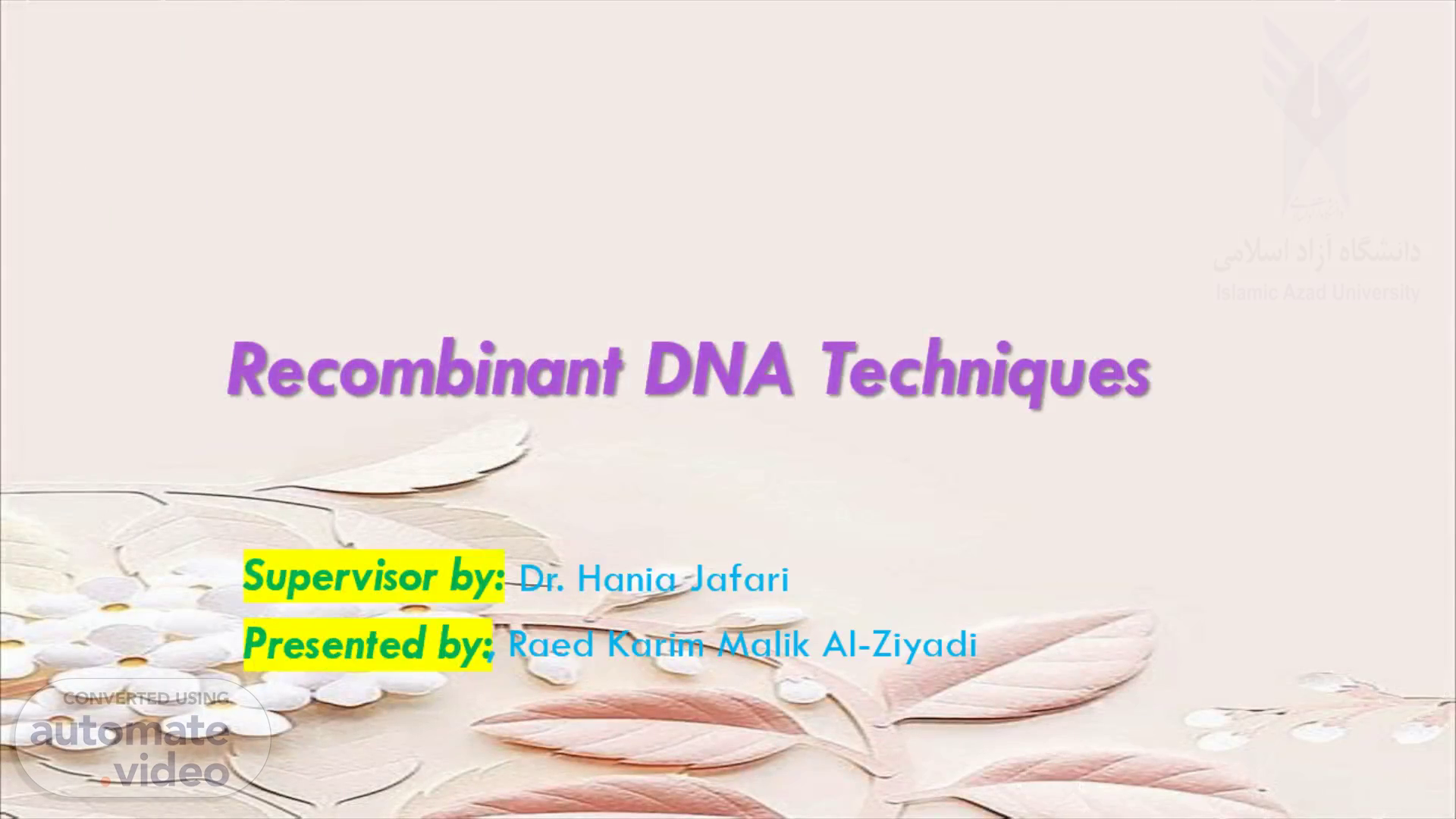
عرض تقديمي في PowerPoint
Scene 1 (0s)
Recombinant DNA Techniques. Supervisor by:. Presented by:.
Scene 2 (11s)
Recombinant DNA technology involves using enzymes and various laboratory techniques to manipulate and isolate DNA segments of interest. This method can be used to combine (or splice) DNA from different species or to create genes with new functions. The resulting copies are often referred to as recombinant DNA. Such work typically involves propagating the recombinant DNA in a bacterial or yeast cell, whose cellular machinery copies the engineered DNA along with its own..
Scene 3 (32s)
DNA cloning. In biology a clone is a group of individual cells or organisms descended from one progenitor. This means that the members of a clone are genetically identical, because cell replication produces identical daughter cells each time. . The use of the word clone has been extended to recombinant DNA technology, which has provided scientists with the ability to produce many copies of a single fragment of DNA, such as a gene, creating identical copies that constitute a DNA clone..
Scene 4 (54s)
AATT vector and donor DNA digested (cleaved) with restriction enzyme AATT TT AATT overhangs mixing DNA ligase added, seals overhangs AATT recombinant.
Scene 5 (1m 2s)
A cDNA library represents a collection of only the genes that are encoded into proteins by an organism. Complementary DNA, or cDNA, is created through reverse transcription of messenger RNA, and a library of cDNAs is generated using DNA cloning technology..
Scene 6 (1m 16s)
mRNA 1 reverse transcription reverse transcriptase 1 cleaved cDNA cDNA digestion with restriction enzymes vectors 1.
Scene 7 (1m 23s)
Principle of Recombinant DNA Technology (4 Steps).
Scene 8 (1m 35s)
vector 0 Host Plasmid Site of cleavage donor DNA AATT T TAA TTAA TT AA AATT bacterial chromosome vector and donor DNA digested (cleaved) with restriction enzyme AATT AATT overhangs mixing ATA DNA ligase added, seals overhangs AA AATT T TAA TAA ATT AAT recombinant DNA molecules Cleavage by Restriction Endonucleases Sticky ends Specified Genes DNA introduced into bacterial cells Point of attatcl and annealing recombinant DNA molecules replicate and cells divide Recombinant Plasmid DNA OvoO O O O 00 clones o o O 0 2012 Encyclopædia Britannica, Inc..
Scene 9 (1m 50s)
Genetic engineering may or may not have recombinant DNA (rDNA).
Scene 10 (2m 6s)
DNA Cloning vector (F>lasr-nid) Cleaved vvith restriction en do n uc ease DNA BYJ u •s Eu karyotic D fragr-r•ent of interest is obtai ned chrornosorne 'A-eith restrictions endonuclease fragrnents are ligated to the prepared cloning vector Recor-n b i a nt vector is introciuced into the host cell Propagation (cloning) produces rnany copies of reconnbinant.
Scene 11 (2m 18s)
The different steps of recombinant technology include.
Scene 12 (2m 42s)
c. Selection of transformed cells (host):. Those host cells that take up the rDNA are identified and selected from the pool ..
Scene 13 (3m 0s)
d is I—ump t.
Scene 14 (3m 7s)
Gene Cloning and Development of Recombinant DNA. Any gene to be cloned must be inserted in a cloning vector (plasmid). A foreign gene (DNA fragment) introduced (by transformation) into a bacterium cell will not be replicated with bacterium. The reason for this is that the enzyme DNA polymerase, which is responsible for copying DNA, does not initiate the process at random. It is initiated at selected sites known as “origin of replication”..
Scene 15 (3m 27s)
. Transfer of Vector into the Host:. The next step in a recombinant DNA experiment requires the uptake by E. coli of the rDNA. The process of introducing purified DNA into a bacterial cell is called transformation. This is carried out by treating cells with calcium chloride and high temperature. A few transformed cells are obtained by this method ..
Scene 16 (3m 46s)
Plasrnid cell cact2 trea for 2 bacteri•ur-n Plasrnid transported intc» the cell Uptake of by bacteria'.
Scene 17 (4m 2s)
4. Transcription and Translation of Inserted Gene.
Scene 18 (4m 9s)
Other methods for selection of recombinant bacteria are:.
Scene 19 (4m 31s)
Foreign DNA Foreign DNA Ligase Ligation Restriction enzymes Cloning Site Plasmid Digestion shutterstock.com • Recombinant DNA 1961761204.
Scene 20 (4m 37s)
Application of Recombinant DNA Technology. DNA technology is also used to detect the presence of HIV in a person. Gene Therapy – It is used as an attempt to correct the gene defects which give rise to heredity diseases. Clinical diagnosis – ELISA is an example where the application of recombinant Recombinant DNA technology is widely used in Agriculture to produce genetically-modified organisms such as Flavr Savr tomatoes, golden rice rich in proteins, Bt -cotton to protect the plant against ball worms and lot more. In the field of medicines, Recombinant DNA technology is used for the production of Ins.
Scene 21 (5m 4s)
REFERENCE. https://byjus.com//recombinant-dna-technology/#applbiologyication.
Scene 22 (5m 23s)
THANK YOU.